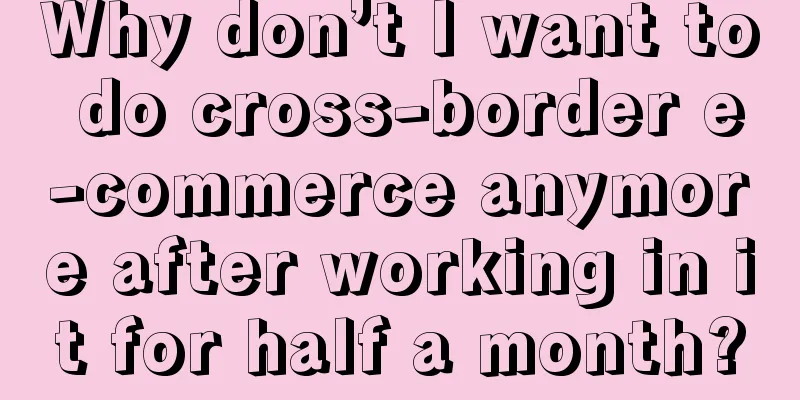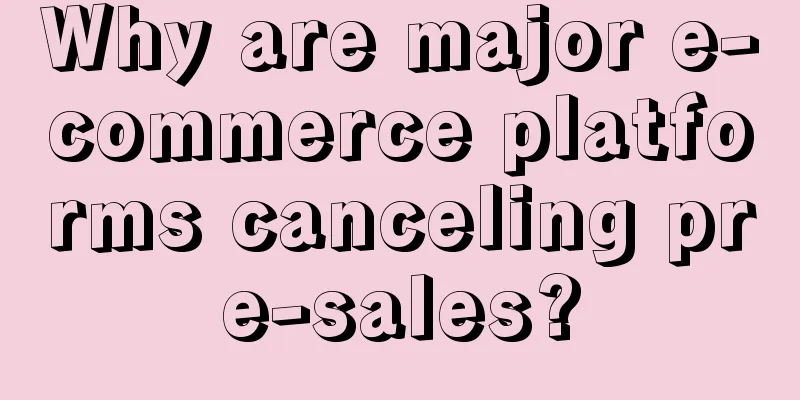Why don’t I want to do cross-border e-commerce anymore after working in it for half a month?

|
As an emerging trade model, cross-border e-commerce has attracted the attention of many entrepreneurs. However, not everyone can succeed in this field. Some people give up after trying for half a month. This article will explore several reasons that may cause entrepreneurs to give up cross-border e-commerce, as well as the funds needed to start cross-border e-commerce. 1. Why do I not want to do cross-border e-commerce after working for half a month? There may be several reasons why entrepreneurs give up cross-border e-commerce in the short term: Intense competition: The cross-border e-commerce market is highly competitive, and it is difficult for new entrants to quickly gain market share. Complex regulations: The laws, regulations and tax policies of different countries are complex and difficult for new entrepreneurs to adapt to. Logistics challenges: Cross-border logistics are costly, time-consuming, and prone to loss or damage of goods. Language and cultural barriers: There are language and cultural differences in communicating with consumers in different countries. Technical threshold: Establishing and maintaining a cross-border e-commerce platform requires certain technical support. Financial pressure: Starting and operating a cross-border e-commerce business requires a certain amount of capital, and the payback period is relatively long. Insufficient market research: Insufficient understanding of target market needs and consumer preferences leads to unpopular products. Lack of experience: Lack of cross-border e-commerce operation experience and marketing skills. 2. How much capital does cross-border e-commerce require? The funds required to start and operate a cross-border e-commerce business vary depending on business size, market positioning, product type, etc. Here are some of the main funding requirements: Platform construction: Building your own e-commerce platform requires investments in website development, server rental, and other expenses. Platform usage fees: When using a third-party e-commerce platform, you may need to pay store opening fees, transaction fees, etc. Product procurement: Depending on the product type and procurement volume, a certain amount of procurement funds is required. Logistics costs: including freight transportation, warehousing, insurance and other costs. Duties and taxes: Depending on the import policy of the target country, you may need to pay certain duties and taxes. Marketing promotion: including advertising fees, promotional activities fees, social media promotion fees, etc. Operating costs: including employee salaries, office space rental, software subscription fees, etc. Emergency funds: used to respond to emergencies such as market changes and policy adjustments. Although cross-border e-commerce has huge market potential, it also faces many challenges. Entrepreneurs may give up in the short term due to fierce competition, complex regulations, logistics challenges, etc. Starting a cross-border e-commerce requires a certain amount of funds, including platform construction, product procurement, logistics costs, etc. |
<<: What are the operating models of cross-border e-commerce?
>>: What are the bitter lessons learned from doing cross-border e-commerce?
Recommend
What countries does Amazon's UAE site include? What about the Middle East site?
There are many Amazon sites, and different sites h...
Can Amazon Multi-Channel Delivery be canceled within one day? How to cancel it?
Amazon multi-channel delivery is a service provide...
Four specific roles of brand
This article introduces four specific roles of bra...
What is the Amazon Compliance Reference Tool? How does it work?
On the Amazon platform, there are many rules that ...
What does Amazon store association mean? What are the reasons for association?
Many merchants on Amazon do not just open one stor...
How to operate community content? Tiantian Fund has the answer!
In community operations, content production is a n...
Taobao launches "WeChat Pay", is China's Internet beginning to fight against involution?
With Taobao announcing that it will support WeChat...
Hot articles fail to bring conversions? How to deal with it?
Many times, Xiaohongshu notes are very popular, bu...
What should I learn and prepare to open a store on Amazon?
Before e-commerce, many people who wanted to buy o...
Live streaming was blocked, millions of fans were lost... A "big brawl" among the top live streaming hosts, is it time for a reshuffle in the industry?
There is no shortage of topics in the live streami...
How to fill in Shopee username? What are the filling tips?
Dear friends, if you want to shop on the Shopee cr...
How to have user thinking?
Why is user thinking so important? This article fo...
How much is the Allegro entry fee? How much does the Allegro genuine version cost?
In today's highly competitive e-commerce marke...
Amazon launches first writable Kindle
Amazon announced that it will launch a new Kindle ...
How to get an account on Shopee cross-border e-commerce? What are the conditions for opening one?
Shopee is a leading e-commerce platform in Southea...









